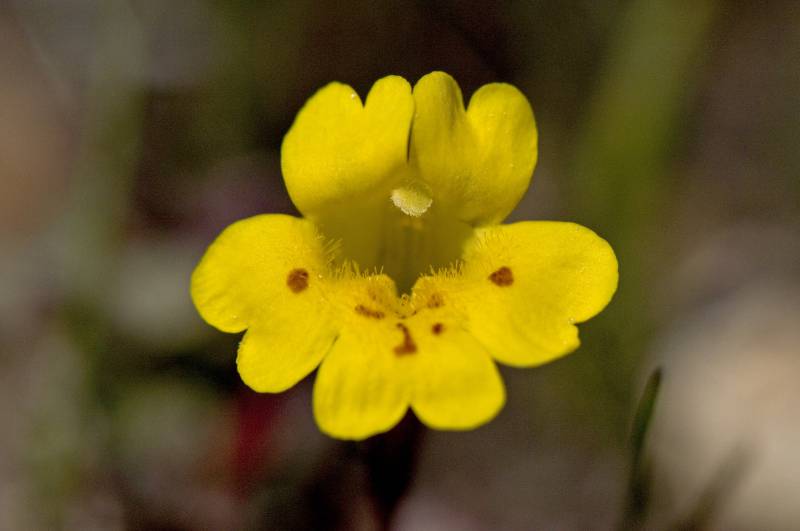Erythranthe primuloides
Erythranthe alsinoides
primrose monkey-flower
chickweed monkey-flower, wing-stem monkey-flower
Leaves opposite, crowded near the ground, short-hairy abaxially (underside), viscid to glabrous adaxially (upperside);
leaves oblanceolate, sessile, nearly entire, 3-nerved from the base, 7-25 mm. long and 3-11 mm. wide.
Opposite, slightly to evidently-toothed, 3-5 prominent veins on the upper surface. The blades are 0.5-2.5 cm. long, with a petiole of more or less equal length.
Flowers solitary on slender pedicels up to 10 cm. long arising from the leaf clusters;
calyx narrow, 4-8 mm. long, mostly glabrous, the 5 teeth short, equal;
corolla yellow, often dotted with maroon, 1-2 cm. long, scarcely bilabiate, the 5 lobes spreading, shallowly notched, the throat somewhat flaring;
stamens 4.
The yellow corollas fuse to form an upper and lower lip (bilabiate), and grow 8-14 mm. long. A conspicuous reddish-brown blotch is found on the lower and sometimes the upper lip. Individual flowers are attached to the stem by a long pedicel.
Capsule.
Capsule.
Erythranthe primuloides
Erythranthe alsinoides
- Local floras:
CA,
OR,
WA
- Local Web sites:
CalFlora,
CalPhotos,
Flora NW,
PNW Herbaria
WildflowerSearch
iNaturalist (observations)
- LBJ Wildflower Center
- SEINet
- Plants of the World Online
- Encyclopedia of Life
- Wikipedia
- Google Image Search
- Local floras:
BC,
CA,
OR,
WA
- Local Web sites:
CalFlora,
CalPhotos,
Flora NW,
PNW Herbaria
WildflowerSearch
iNaturalist (observations)
- LBJ Wildflower Center
- SEINet
- Plants of the World Online
- Encyclopedia of Life
- Wikipedia
- Google Image Search



